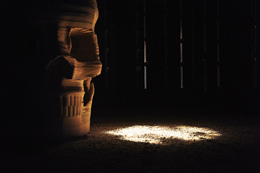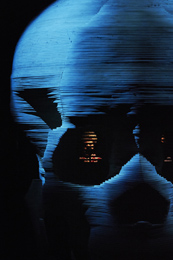Beckett in a note on his radio play All That Fall warned against adapting it for the stage insisting that "to act it is to kill it," ruining his desired effect that the piece would be "coming out of the dark." No such note is attached to his 1959 BBC produced radio text Embers but as this piece is even more resistant to representation than All that Fall, Beckett’s previous comments would seem even more apt. What is remarkable about Pan Pan’s theatrical production of Embers is how well the company under the direction of Gavin Quinn manage to challenge but also adhere to Beckett’s demands, creating a most singular theatrical experience.
 In the radio play we retreat into the mind of a character named Henry who is sitting by a strand. His mind jumps, starts, gets stuck and finally goes silent as he tries to escape the continual inexorable ‘suck’ of the sea. He tries to summon up the ghost of his father to sit with him on the strand, remembers his daughter, speaks with his dead wife and attempts to narrate an unfinished story about a doctor named Holloway who visits a man named Bolton whose chamber has burned down. Throughout he draws attention to the medium of radio by punctuating his speeches with tired studio sound effects such as the sound of horses’ hooves and the dripping of a tap. The piece continues Beckett’s artistic exploration of the value and limitations of performance in its contradictory ability to make an absence present and to publicly communicate human subjectivity.
In the radio play we retreat into the mind of a character named Henry who is sitting by a strand. His mind jumps, starts, gets stuck and finally goes silent as he tries to escape the continual inexorable ‘suck’ of the sea. He tries to summon up the ghost of his father to sit with him on the strand, remembers his daughter, speaks with his dead wife and attempts to narrate an unfinished story about a doctor named Holloway who visits a man named Bolton whose chamber has burned down. Throughout he draws attention to the medium of radio by punctuating his speeches with tired studio sound effects such as the sound of horses’ hooves and the dripping of a tap. The piece continues Beckett’s artistic exploration of the value and limitations of performance in its contradictory ability to make an absence present and to publicly communicate human subjectivity.
Pan Pan’s production opens on a stage full of pebbles with hundreds of small circular speakers on cables suspended from the ceiling, marking the setting both as a strand and a radio studio-of-sorts. Four characters emerge and walk in between the speakers not interacting with each other but lost in thought while a piano (Andrew Synott) softly plays. Then Andrew Bennet, who we are soon to learn is playing Henry, removes a black cloth from a large object centre stage. He reveals a four metre high wooden sculpture of a human skull (strikingly rendered by Andrew Clancy) that stares directly at the audience inviting them to play Hamlet and face their mortality. The actors disappear and Bennett’s wonderfully gravelly but yet beguiling voice begins to emerge from the caverns of the giant cranium. It is a voice "coming out of the dark" but located within a defined headspace. The entire radio play is then performed via microphone from the sculpture for the duration of the piece while Aedín Cosgrove’s marvellous lights caress, illuminate and darken the skull impressing dreamlike images upon the audience’s minds that sometimes illustrate, contrast and forget Beckett’s words coming through the speakers.
 The piece is thus not acted (but spoken) and not killed by a literal representation. That is not to say that the actors do not contribute to this production. Bennett’s delivery as Henry is haunting and dangerous redolent of the description of the sound of embers described in the play: "Shifting, lapsing furtive like dreadful sound." While Ní Mhuirí makes his wife Ada enigmatic and otherworldly by voicing her with beautiful restraint and distance. The two short scenes with Henry’s daughter Addie (Mulcahy) and her teachers (Reardon) are well done and terrifying in their violence made worse through its amplification by microphone which hurts the ear. The soundscape designed by Eadie which includes the sounds of the sea, shifting shingle, loud drips and horses’ hooves nicely complements the voices, set and lights, although, to complement in this production does not mean a movement towards a unified creation where all elements work together.
The piece is thus not acted (but spoken) and not killed by a literal representation. That is not to say that the actors do not contribute to this production. Bennett’s delivery as Henry is haunting and dangerous redolent of the description of the sound of embers described in the play: "Shifting, lapsing furtive like dreadful sound." While Ní Mhuirí makes his wife Ada enigmatic and otherworldly by voicing her with beautiful restraint and distance. The two short scenes with Henry’s daughter Addie (Mulcahy) and her teachers (Reardon) are well done and terrifying in their violence made worse through its amplification by microphone which hurts the ear. The soundscape designed by Eadie which includes the sounds of the sea, shifting shingle, loud drips and horses’ hooves nicely complements the voices, set and lights, although, to complement in this production does not mean a movement towards a unified creation where all elements work together.
Instead, here we have the opposite, where theatrical performance is clearly separated into its constituent parts. That is to say, we experience the lighting, the setting, the words, sound effects, the timbre of voices as a sum of parts that does not make a whole, but rather (to channel Beckett for a moment) makes a ‘hole’ (an absence of coherence).
Such an effect was for me a deeply immersive and indeed overwhelming experience and I must confess like a Beckettian character at times I wished to go but felt oddly compelled to stay. However, in the days since attending this performance I have found my mind continually drawn back to the inexorable ‘suck’ of the play and this production’s lasting achievements.
Ian R. Walsh is a lecturer in Drama at University College Dublin and has recently published his first book Experimental Irish Theatre, After W. B Yeats.